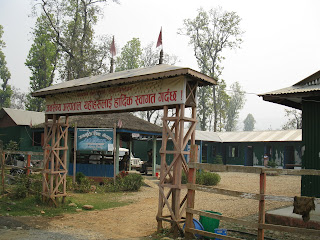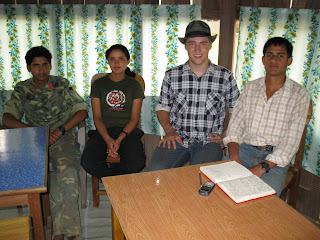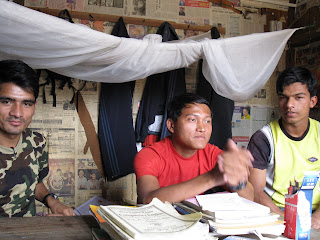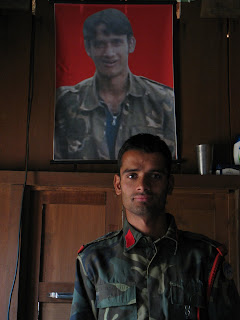Eyewitness reports from the Nepal's revolution

By Ben Peterson
[The following are a series first-hand reports from Nepal, by Australian socialist activist Ben Peterson, a member of the Democratic Socialist Perspective and the socialist youth organisation Resistance, both affiliated to the Socialist Alliance. They first appeared at Ben's blog, Lal Salam, and are posted at Links International Journal of Socialist Renewal with his permission.]
* * *
First impressions and adventures in Nepal
March 6, 2009 – And here I am. After too long speculating from the sidelines (and sidelines 10,000 kilometres away) I have finally arrived in the land of Mountains and Maoists. On Tuesday night at about 10 pm, I landed in Kathmandu to see with my own eyes the processes unfolding here.This is less of an in-depth analysis and more of a account of my personal experiences so far, which have been really intense.
I was met at the airport by a political comrade of mine, Narendra Jung Peter. He has been an amazing help so far, and amongst many other things has helped arrange a room to stay, a sim card and introductions to already a mind-boggling amount of people.
So it wasn't until Wednesday that I got to look around Kathmandu a little bit. It's an amazing place, and so unbelievably different to the comforts of the West. To describe it best I think all that really needs to be said that it is loud, chaotic but amazingly open and friendly. I've been lost a few times already, but everywhere I go there are people more than happy to help me out, and have a chat which has been great.
There is a lot of political graffiti and posters on the walls in Kathmandu. Most of it, at least where I am staying, is just residual stuff left over from previous events. There is still a lot of stuff left over from the election, most of it Maoist [United Communist Party of Nepal (Maoist) – UCPN (Maoist)]. I have some good photos. Their are also a lot of posters, where I am they are mostly related to the Communist Party of Nepal (United Marxist Leninist) UML congress that was held two weeks ago. There was also some I saw in another part of the city advertising a program for the Newari (an ethnic group) National Liberation Front. I am pretty sure this is a Maoist group, but unfortunately it has already taken place, so I couldn't attend. There have also been posters around where I am staying for the local shopkeepers' union, but I have not yet found anyone to translate them for me.
There is some more recent stuff, there was a big slogan on one wall from the Maoists women's group, which is organising something in regards to International Women's Day, which I saw around, but the areas near the schools and universities are saturated with material, due to the ongoing student elections. Hopefully I will be able to make contact with some of these students and get an insight to the student movements, as the struggle here has been fierce, often escalating into confrontations.
The last few days have been amazingly intense. I haven't had time to think, it's been really crazy, but so amazingly rewarding. Again, Comrade Narendra Jung Peter has been an invaluable contact, and I already owe him more than I thought possible.
Yesterday I got up early to go see the Dabur Square. It is an amazing place, it is the central square of Kathmandu and has temples and other architecture dating back literally over a thousand years. It is an amazing mix of Nepali culture and architecture which is so amazingly impressive, with smaller additions and influences taken from other cultures that passed through the valley, as Kathmandu is on what was the traditional trade route between India and Tibet/China.
The exception to this rule of subtle influences is the domination of the beastly building that is sort of tacked onto the side of the old royal palace which is based on the Bank of England building in London. There is nothing subtle about the imposition of this palace extension, and if endemic of the fact that while as a independent nation Nepal was able to resist becoming a part of the British Empire, the cultural (and economic) imperialism wasn't able to be stopped at the border.
After seeing the Darbur Square Narendra called me and invited me to a meeting at the Ministry of Communications and Information on the need to spread responsibility and accountability within the media of Nepal. Present at the meeting where ex-ministers, heads of journalist federations, veteran and respected journos, academics and editors... and me. Needless to say I felt a little out of my depth, especially as I don't speak a word of Nepali, but it was still a good experience that I am very grateful for.
Their are many issues in the media at the moment. Firstly and foremost, there is the issue of the Army integration, which has recently flared up. The (ex-royal) Nepali Army recently went ahead and recruited several thousand new members, despite it being against the interim constitution, the peace agreement, the supreme court and the directions of the government and defence ministries. However only in the last couple of days, in response to this, has the People's Liberation Army also started a process of recruitment. The right-wing media is now starting a shit storm about how the PLA is putting the peace process in jeopardy and the UCPN (M) is at fault. It is a ridiculous argument, and the root cause of a the current issues is that the army is still loyal to the royals and the opposition, and not to the government.
There is also the issue of the load shedding. Kathmandu is without power for up to 16 hours a day, which naturally is causing massive disruption to people's lives and to the economy. While Nepal is a Third World country and it definitely has issues with energy, there has recently (since the Maoists formed government) has been a noticeable increase in the problem. While there no doubt has been chronic underfunding from the government for energy for years, I think that the recent increase in the problem is suspicious to say the least.
I will try and write articles on all the issues and also try and get some interviews done. I also need to go to the countryside and see things a bit better as well and meet the rural people.
On a final note, the comrades I have spoken too here have really enjoyed Green Left Weekly. I highly recommend it, it's a great paper and that will be writing for it.
The PLA recruits – what is the future of the peace process?
March 8, 2009 – On March 3, the People's Liberation Army (PLA) of Nepal, which fought a ten-year war against what was then the Hindu Kingdom of Nepal started recruiting new soldiers to fill vacancies within this force. This has been hailed by the media and political opposition (both inside and outside of the government) as a major hit to the integration of the armies and has been said to put the peace process in jeopardy.
However to come to these conclusions one has to disregard the facts and the real issues surrounding this recent controversy. This recruitment has been in response to a recruitment by the (ex-Royal) Nepal Army. The recruitment by the army took place against the instructions and orders of the defence ministry, the government, the Supreme Court, yet did not receive the same condemnation from the various political parties in opposition.
The political opposition, lea by the Nepali Congress, has called for this recruitment to be stopped, and has demanded that the United Communist Party (Maoist) halt the recruitment. However the UCPN (M) is not in a position to do so, as the PLA no longer the military wing of that party. It has repeatedly been stressed by both the UCPN (M) and the PLA that the PLA now takes its directions from and is loyal to the civilian government.
The PLA and the UCPN (M) both continue to reconfirm their commitment to the ongoing peace process and the process of creating the new Nepal. It is the Nepal Army, with the political support of the opposition, which is putting the peace process in jeopardy and continues to move against the spirit of the people's movement of 2006 and the mandate given to the Maoist-led government in the constituent assembly elections last year.
When placed in a position where despite its commitment to the peace process and the government, its opponent in the Nepali Army continues to grow and build its strength, the PLA is left with no option but to follow suit.
The peace process only can be brought to a logical conclusion when the two forces are integrated into a new, democratised national army, loyal only to the new Nepal. Contrary to the opinion of the political opposition, the most pressing need in this matter is not to rehabilitate the PLA into the community, but (as this whole episode shows) to bring the rogue army back under the control of the civilian government, and dissolve both of these forces and then reintegrate them into a new national army for the new Nepal.
This however will be a struggle for the Maoist-led government as those inside and outside the army will fight tooth and nail to preserve it in its current state as insurance for the status quo. It is clear to most observers that while the king may be gone and the constitution is still being written, the shape and form of the new Nepal is anything but certain, and is still to be played out in the future.
Some pictures and thoughts from the Peoples Liberation Army.
March 28, 2009 – For the last week I have been with the JanaMukti Sena, the Peoples Liberation Army. Mostly with the 3rd Division, Kalyan/Anish Memorial Brigade.
 This
is the Peoples/Military Hospital. Set up by the Peoples Liberation Army, it now
serves both it and the public. It has many facilities, including a
pharmacy, an operating room for minor surgeries, a pre- and post-natal care
facility and a female ward. It was built by the PLA, and runs at next
to no cost for the people of the area. (I also fell ill at the camp,
and it cost me 10 rupees, about 20 Australian cents, which included my
medication.)
This
is the Peoples/Military Hospital. Set up by the Peoples Liberation Army, it now
serves both it and the public. It has many facilities, including a
pharmacy, an operating room for minor surgeries, a pre- and post-natal care
facility and a female ward. It was built by the PLA, and runs at next
to no cost for the people of the area. (I also fell ill at the camp,
and it cost me 10 rupees, about 20 Australian cents, which included my
medication.)


These were two married comrades (please forgive, I only briefly met them and didn't record their names). He was tending to their child while she was studying for her school-leaving certificate. They are representative of many in the camp. Many of the people I spoke to were studying. As many members left school to join the PLA, many of them are now not qualified. Many others just simply didn't have access to any real sort of schooling.The PLA is now like a university – everywhere people are studying something.
This is also a common scene, men often spend a lot of time tending to the children. In fact in my time there I saw no division of labour based on sex – women often could be seen with axes and saws in hand going off to cut wood while the men stayed to cook, clean and care for the children.

From left to right, Comrade Rakess, Comrade Sasila, myself and Comrade Agragg. All aged in their early 20s, from the 6th Battalion. Rakess left his wife and family in the village in order to fight. Agragg has recently had his first child with his wife, who is an activist with the All Nepal Women's Organisation (Revolutionary). Sasila came from a relatively wealthy background, but rebelled against it to join the fight against the caste system and injustice in her country.
Their interview of me went for at least as long as my interview with them. Once they found out I was a progressive journalist they were full of questions about Australia, the struggle here, how strong the socialists are, our government, our government's relations with Nepal and with the United States, the nature of imperialism, and what were the conditions for people in Australia. Many journalists come to these camps and hear political talk from people, who were previously peasants, and write it off as “brainwashing'' by some evil party. These people are often uneducated, but they are not stupid. They know exactly what they are doing and why. They are thinking things through, and they crave information. People who want to write off the "simple" people of Nepal -- do so at your own peril.
This brigade was made up of a little over 20% women, which is below the average for the PLA. But while women were a minority, and are still under represented in the higher ranks, they are in my experience much more serious as a general rule. Some of the male comrades were sometimes a little hazy, but the women were often the most political and well read. Men on guard duty would often talk to me if I asked, while on duty the women would direct me on to someone else.
 Left to right are Comrade Sedanta, (comrade's name unknown) and Comrade Krishna. Sedanta was a medic
in the rebel army, but was wounded himself. All three are currently
studying, the books in the foreground are test papers for the coming
exams. The middle comrade is a Bhutanese refugee. Almost 20 years ago
Bhutan violently expelled a sixth of its population who were ethnic
Nepalis. His dream is that after helping the struggle here in Nepal, he
will be able to return to his homeland and help the struggle against
the violent and racist monarchy there.
Left to right are Comrade Sedanta, (comrade's name unknown) and Comrade Krishna. Sedanta was a medic
in the rebel army, but was wounded himself. All three are currently
studying, the books in the foreground are test papers for the coming
exams. The middle comrade is a Bhutanese refugee. Almost 20 years ago
Bhutan violently expelled a sixth of its population who were ethnic
Nepalis. His dream is that after helping the struggle here in Nepal, he
will be able to return to his homeland and help the struggle against
the violent and racist monarchy there.
 Comrade Sedanta again. He was shot by the Army while tending to wounded. That's his scar.
Comrade Sedanta again. He was shot by the Army while tending to wounded. That's his scar.
Sunil is a vice-battalion commander. He is engaged to be married in a couple of months. He is from a poor farming family in the north of Nepal. His dream is that Nepal will be developed and his family won't be impoverished and everyone will be treated with respect.
The picture behind him is that of his older brother. His brother shared this simple and reasonable hope for something better, and he died for it. He was killed by the military during the war.
 This
is Sriganna. She is an inspiration. She is the vice-battalion
commander, highest ranked woman in the brigade. He room is packed full
of political books and magazines, and is clear on her politics, she can
always be seen talking to people around the camp, especially the other
women. She lost both a sister and a brother during the war to the
repression by the army. Due to a complicated political issue I
wont go into at present her husband is in jail. Still she is always
smiling.
This
is Sriganna. She is an inspiration. She is the vice-battalion
commander, highest ranked woman in the brigade. He room is packed full
of political books and magazines, and is clear on her politics, she can
always be seen talking to people around the camp, especially the other
women. She lost both a sister and a brother during the war to the
repression by the army. Due to a complicated political issue I
wont go into at present her husband is in jail. Still she is always
smiling.
She and all the people here are just happy with what they have already achieved. They can now be optimistic about what the future of their people has in store.
A week with the people's army
March 29, 2009 – Chitwan is famous around the world for its national park. In the midst of the jungle there are rare and exciting animals. Rhinos and elephants and tigers, and all a manner of things that every year thousands of Westerners flock to see, for they cannot be seen anywhere else in the world.
And as a very western foreigner I too descended out of the hills and comfort of Kathmandu and into the jungle, but not in search of any of this. The jungles of Chitwan hold something much more important than endangered animals, and something just as rare. It is a force that has been unleashed and fed by the huge discontent in the country and turned upon the people's oppressors with a fury and enthusiasm that has been a major factor in bringing about and continuing the enormous process of change that is ongoing in Nepal.
In the jungles of Chitwan waits the JanaMukti Sena – the Peoples Liberation Army.
The mainstream media and a wide range of non-government organisations talk of this army as child soldiers and human rights abusers. A dictatorial leadership that has played on the insecurities of the poor, an uneducated peasantry, and forced them into their army. At any rate, the PLA proved themselves to be a formidable fighting force. During the war they repeatedly beat back the Royal Nepalese Army, despite it being funded, armed and trained by international superpowers such as the USA, UK and India.
So in the face of this I really did not know what to expect, however despite all the reports and propaganda, I didn't meet child soldiers, starving and home sick, and I didn't meet indoctrinated and brainwashed drones determined only to follow their party. This was a people's army, and all that was to be found were people.
The people of Nepal have had enough of the grinding poverty in their society. They have had enough of the parasitic monarchy that lives in phenomenal wealth while the people starve. They have had enough of hollow democracy that talks but never provides. They have had enough husbands, sons and fathers being sent overseas for work, of daughters, mothers and wives being left alone to work at home or sold into the sex trade. They have had enough of the indignity and defeat that had been forced upon them, and when a clear path to fight against it was given, they enthusiastically took up the challenge.
The idea that these amazing people are ignorant and being exploited is insulting to the sacrifices they have made. The whole camp is now like a school, people who either left school early to fight or never had the opportunity to study in the first place are now deep into their books, studying at all levels and in all subjects.
They understand why they fought and what they set out to achieve, and their thirst for knowledge is unquenchable. I could barely get questions in for interviews, as the people were always asking about my experiences, my country and its foreign policy, and ideas for development here in Nepal.
There is nothing to prove that the People's Liberation Army is blindly and dogmatically politicised. The PLA is a political people's army, but its political dreams are for development, democracy and equality. All who I talked to said that their dreams were for Nepal to be developed and that their children could study and then work in Nepal, without the crushing poverty, and without the oppression and discrimination against ethnic minorities, women and people of low caste.
But while this is an army of the people, from the people and for the people, there was clearly a massive effort to do away with the many problems that plague Nepali society. People of all castes stood on equal standing. There were inter-caste marriages that would never have been possible before the people's war. While there was officers, there was little distinction between them and the rank and file. Everyone ate and cleaned in common. Importantly women, who were often forced into a cruel existence previously, enjoyed a much higher participation and involvement in society. Men could often be seen caring for the children and cleaning the home while the women used their time to study or go off axe in hand to chop wood.
A week with the PLA was a painfully short time, and I only met a fraction of the people and heard a fraction of the stories available but it is clear to anyone that sees the amazing people of the JanaMukti Sena's almost 30,000 members that they are some of the best sons and daughters of this country – and if their hard work and sacrifices are allowed to go to developing this nation, then the future of Nepal will one that is radically different.

